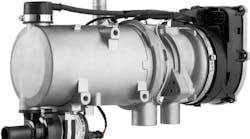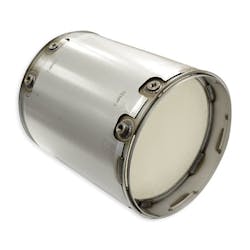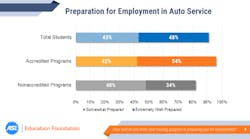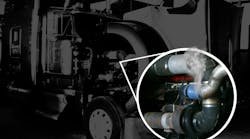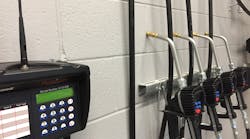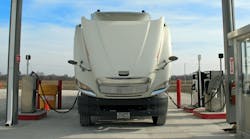A recent fleet study conducted by Webasto Thermo & Comfort North America, in conjunction with Fleet Maintenance magazine, found that a remarkable 87 percent of those surveyed did not know how much their fleet was spending annually on diesel particulate filter (DPF) cleaning.
Perhaps more alarming was that 65 percent of respondents reported not knowing how much their fleet was spending annually to replace damaged and inoperable DPF filters.
An overview of the DPF
A DPF device is deceptively simple in concept, yet it operates in a complex environment.
The DPF is designed to reduce pollution by trapping soot and particulate matter (PM) from a diesel engine’s exhaust gas, so it is not released into the atmosphere. After engine combustion, exhaust gas is directed through a ceramic filter substrate with finely porous walls. A portion of the filter walls are also coated with a catalyst material, often platinum or palladium, known as a “wash coat.”
The filter traps the soot and PM while deposits of these materials form on the walls of the filter. When the collected material reaches a pre-determined level, sensors monitoring back-pressure activate the filter regeneration process.
The regeneration process occurs automatically when the engine is operating at optimum high temperatures. The catalyst is heated to soot combustion temperatures, converting soot and PM materials into ash. The ash deposits are stored in the filter cavities for later extraction through routine cleaning in the shop. The frequency of the DPF cleaning intervals is directly proportionate to engine condition and duty cycle. It is important to note with each DPF cleaning a portion of the wash coat is sacrificed.
If you'd like more information and articles like this in your inbox, subscribe to the Fleet Maintenance Today newsletter.
Consequences of cold-start events
In a cold-start scenario, the DPF’s catalyst is too cold to perform its regeneration function.
An engine that starts cold will emit un-combusted fuel and PM into the DPF, resulting in a heavy, wet and dense soot buildup that increases back-pressure. This can result in reduced engine and DPF efficiency. Face plugging and filter overload are often the result. Cold starts also create the need for more frequent DPF cleanings, which shorten DPF effectiveness and, ultimately, lifespan.
Factor in downtime for cleaning DPFs and replacement costs can range between $2,500 to $8,000 per vehicle. With these potential costs directly impacting every diesel-powered vehicle operator’s bottom line, cold starts are a hot topic within the commercial vehicle industry.
The increased impact of high-idle run times
Some industry experts suggest that it’s not unusual for idling time to represent as much as 45 to 50 percent of a vehicle’s run time. All those non-productive hours translate into a lot of wasted fuel and a tremendous overhead cost for fleets. According to the U.S. Department of Energy, a long-haul truck idles about 1,800 hours per year, and uses about 1,500 gallons to do so.
What does this have to do with DPFs? An idling engine is a terrible thing for a DPF. In fact, until the DPF is operating at between 842 to 1,112 degrees F (450 to 600 degrees C) – generally at road speeds and well above idling temperature – it’s using its DPF as a virtual garbage can for the collection of soot and PM.
Just as in cold-start events, excessive engine idling allows the exhaust, and thus catalyst, temperatures to drop below their optimal levels, causing the DPF to lose efficiency. At the same time, PM emissions from the cooler engine increase, causing the DPF to be overwhelmed.
The same basic temperature-related problem can occur in vehicles with short duty cycles. For instance, if a truck that has been operating just fine with no DPF issues on a long-distance duty cycle changes its route to accommodate the lower speeds and high traffic of last-mile delivery, it’s bound to have a performance change. Once again, the catalyst can’t maintain regeneration temperatures and the DPF becomes overloaded and plugging can result.
Proper DPF cleaning
Unless properly cleaned when required, a DPF may be damaged, reducing its efficiency and lifespan. Cleaning a DPF incorrectly can also void its warranty. Not only must the powdery ash be removed, but carbon deposits may tenaciously adhere to the DPF’s ceramic surfaces and intricate passages. In order for the DPF to function properly, these contaminants must be removed without damaging the filter’s catalytic wash coat.
Cleaning DPFs requires technical skill and a precise knowledge of the manufacturer’s specific recommendations. Depending on the make, model and circumstances, cleaning methods may include compressed air, heat or a combustion cycle booth. Cleaning should be performed by a qualified person or service facility.
Preventing DPF problems with pre-conditioning
Pre-heating or pre-conditioning a diesel engine with a fuel-operated heater (FOH) warms the engine and its fluids to about 165 degrees F before the engine is ever started. These devices operate on diesel fuel drawn directly from the vehicles primary fuel tank.
FOH pre-heaters save fuel by reducing idling time, warming engines so they start more easily and by eliminating long engine warm-ups. In addition, one of the most important things FOHs do is reduce maintenance costs as a byproduct of reducing the burden on emission control devices, like DPFs.
Popular products, like Webasto coolant heaters, have been proven to reduce cold, dense soot by up to 66 percent during engine startups, while also reducing nitrous oxide emissions by up to 40 percent, according to independent lab testing referenced in TMC RPs 432 and 1102.
By raising the initial engine temperature at startup, these devices can help reduce the time it takes for the DPF to become active, reducing the “wet stacking” often produced by cold engine starts.
With pre-heating the entire power unit, engine oil is warmer, sealing piston rings and diminishing engine blow-by, while decreasing the amount of “carry over” oil in the exhaust stream. Warmer injectors increase fuel efficiency, and diesel exhaust fluid (DEF) tanks and injectors are also protected from freezing in cold climates, thus increasing their overall efficiency and reliability.
By minimizing the wet, dense soot and PM emissions associated with cold engine starts, pre- conditioning reduces filter overloading and face plugging, and significantly increases the time between cleaning intervals.
When drivers start a pre-heated engine, they also immediately get warm air from the HVAC system.
A number of FOH products are listed under the “Verified Idling Reduction Technologies” category by the U.S. Environmental Protection Agency SmartWay Program. Coolant heaters are extremely fuel efficient in helping achieve optimal engine starting temperatures while reducing engine wear, fuel consumption and exhaust emissions. An engine pre-heater also delivers a fast ROI in the form of reduced DPF maintenance.
If you'd like more information and articles like this in your inbox, subscribe to the Fleet Maintenance Today newsletter.
Duane Bratvold uses his expertise in emissions standards to provide fuel-operated heaters and other emissions management solutions for fleets of trucks, buses and off-highway equipment. He serves as Webasto’s corporate expert on emissions and is respected within the commercial vehicle industry for his vast knowledge and 36 years of experience within the diesel emissions sector. Over his career, he has worked in partnership with many state and federal municipalities on emissions and retrofit initiatives. Bratvold has also worked with DPF and engine manufacturers, giving him a unique understanding of the effectiveness of emission control devices and their many applications.
